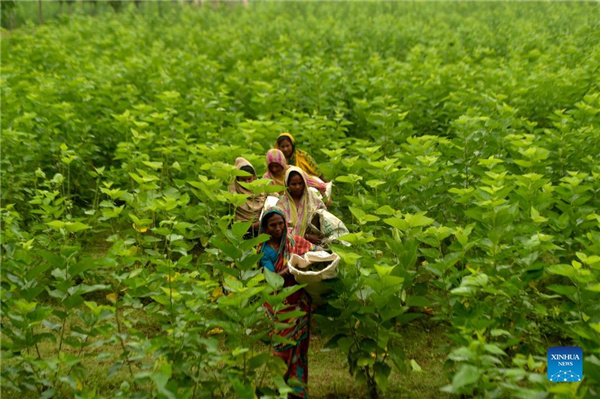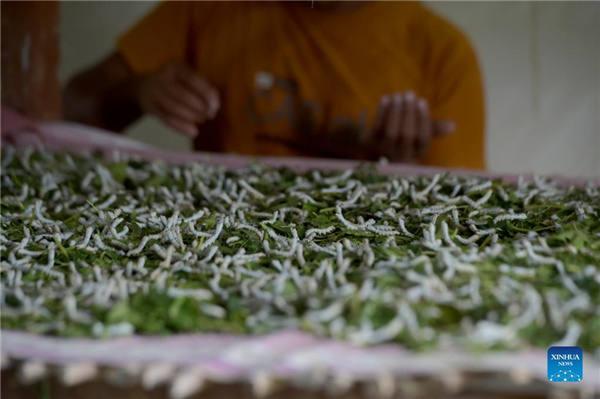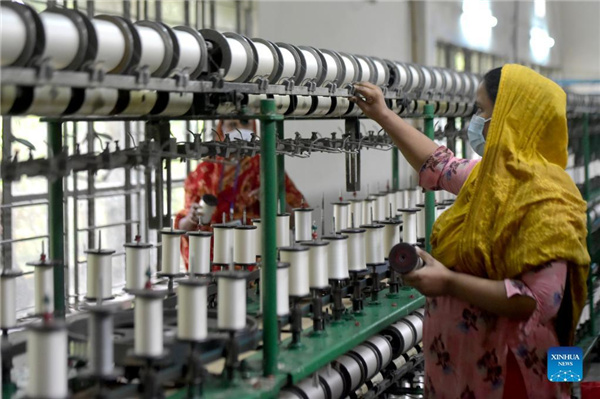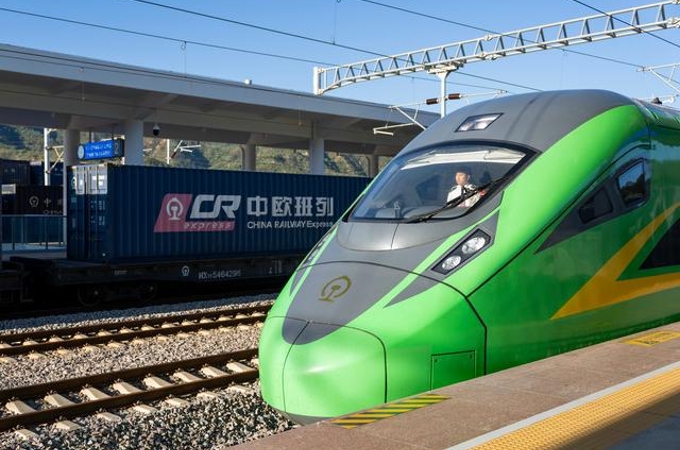Feature: China tradition, Bangladesh vision -- Rajshahi silk on road to success
Source: Xinhua | 2021-11-30 | Editor:Lexi

Workers carry sacks of mulberry leaves at a silkworm farm of Aarong, a social enterprise, in Manikganj, Bangladesh on Nov. 15, 2021. (Xinhua)
Many centuries ago, silkworm cultivation and silk-making techniques from ancient China reached Bangladesh along the Silk Road, an ancient trade route.
For almost all its history, sericulture was confined to the Rajshahi region in the western part of Bangladesh. Today, based in Manikganj to the northwest of capital Dhaka, Aarong, a social enterprise backed by BRAC, a local NGO, has brought Rajshahi silk to the global marketplace.
FAMILY CONCERN
BRAC was founded in 1972 by Fazle Hasan Abed as a small relief and rehabilitation project. In April this year Rajshahi silk was given Geographical Indication status, providing new livelihoods and opening up opportunities for hundreds of thousands of people, mostly women, in rural Bangladesh to become self-reliant.
Rina Akhter is one of the beneficiaries of Aarong's success in supplying fine silks to the high-end garment industry. A Manikganj local, Rina is a mulberry-leaf picker who has worked at Aarong's silkworm farm for about five years.
"I have three children - two daughters and a son. My husband and I also work together (here)," she told Xinhua, thanking Aarong for the opportunity. "We're doing well, by the grace of God. The cost of living is not much, so we lead a good life. "
Moshammad Anna Akhter weaves silk on traditional wooden hand loom. She can make a seven-meter sari in a day. "If I do my best work, and the fabric I make is good enough, I am paid more for my production. I get a good salary. In fact, I get the highest salary in this workshop. My family does very well with my income."
KNOWLEDGE AND KNOWHOW
Abdul Mannan has been working with BRAC for 30 years. BRAC started its silkworm cultivation in 1978. "The program began here in Manikganj and has gradually expanded," he said.
"BRAC now has 12 farms spread all over the country. We have a hand in the whole supply chain from raw leaves to stores. We grow mulberry bushes, rear the silkworms to the cocoon stage, then extract, spin, dye and weave the silk, eventually making high-quality saris, dresses and other garments, mostly for women. We sell many of our products through Aarong's own outlets."
Silkworm cultivation started in China, where the world's expertise still lies. "I know China is the most advanced silk producing country. There is a lot of research on silkworm cultivation in China. We are lucky enough to benefit from China's huge knowledge base and current research. Chinese knowhow and new technology are crucial to our results," Mannan said.
"I think that if we want to improve our farming program, then we have to follow China's lead. Those of us who work with silk in Bangladesh must visit China often to learn the latest techniques," he said.
FOR THE GOOD OF THE COMMUNITY
Aarong Chief Operating Officer (COO) Mohammad Ashraful Alam said, "The vision our founder Sir Fazle Hasan Abed regarding the revival of silk industry in Bangladesh has guided us since 1976. We still adhere to that same vision today."
"BRAC is the only business in Bangladesh involved in the entire value chain of silk production. We sell through 22 Aarong brick-and-mortar shops around the country and through our own e-commerce platform. We ship to the USA, UK (Britain) and Australia."
"We have no plans to stop there. We plan to continue to champion Rajshahi silk and other local craft industries, expanding our horizon as a global brand. But our true, original mission as set by our founder is dedicated to the welfare and wellbeing of all our workers." (by Naim-Ul-Karim)

Photo taken on Nov. 15, 2021 shows a worker extracting silk threads from cocoons at a farm of Aarong, a social enterprise, in Manikganj, Bangladesh. (Xinhua)

A worker takes care of silkworms at a farm of Aarong, a social enterprise, in Manikganj, Bangladesh on Nov. 15, 2021. (Xinhua)

Workers make silk fabric at a factory of Aarong, a social enterprise, in Manikganj, Bangladesh on Nov. 15, 2021. (Xinhua)

Workers process silk threads at a farm of Aarong, a social enterprise, in Manikganj, Bangladesh on Nov. 15, 2021. (Xinhua)
You May Like
-
BRI boosts economic exchanges between China, ASEAN
Counting their harvest from the Singles' Day online shopping festival, Thai livestreamer Namfon Lapjulpon and her Chinese husband could not help humming songs. ...
InKunming 2021-11-23 -
Shenzhen's trade with B&R countries in Jan-Oct up 12.9 pct
The southern Chinese city of Shenzhen saw its imports and exports with countries and regions along the Belt and Road (B&R) grow to 606.1 billion yuan (94.9 bill...
InKunming 2021-11-23 -
China's green BRI a boost to global climate governance
China on Tuesday summarized in a landmark resolution the sweeping, historic and transformative changes in its ecological and environmental protection endeavors.
InKunming 2021-11-23 -
Xinjiang opens wider to world under Belt and Road Initiative
Argentine Ambassador to China Sabino Vaca Narvaja has seen with his own eyes how the Belt and Road Initiative (BRI) brought changes to northwest China's Xinjian...
InKunming 2021-11-19 -
BRI enhances innovation, sustainability, bolsters global rec...
The Belt and Road Initiative (BRI) has evolved into a beacon of economic growth for participating countries with more emphasis on innovation and sustainability,...
InKunming 2021-11-19 -
China's Guizhou launches first direct China-Europe freight t...
The first direct China-Europe freight train service linking southwest China's Guizhou Province and Russia's Moscow started service Thursday.
InKunming 2021-11-19 -
Interview: Lao business leader dreams of China-Laos railway ...
The upcoming opening of China-Laos Railway will represent the end of a long "road of dreams" for the Lao people, Daovone Phachanthavong, the vice executive pres...
InKunming 2021-11-19 -
Digital exhibition endeavors to bring Silk Road history to l...
A digital exhibition platform has been set up in Dunhuang, a city along the Silk Road in northwest China's Gansu Province, showcasing the country's 40 world her...
InKunming 2021-11-19 -
Belt and Road, a pathway to a brighter future
The joint construction of the BRI projects conveyed confidence and strength to the international community and made important contributions to global anti-epide...
InKunming 2021-11-19 -
Talent education cooperation continues along the China-Laos ...
A dynamic testing train departs from China's Kunming Railway Station and heads to Mohan Station on the China-Laos Railway, signaling the completion of a compreh...
InKunming 2021-11-17







